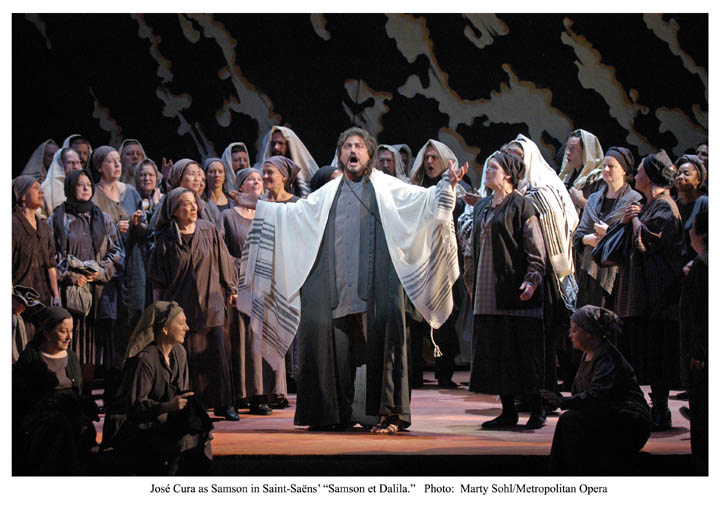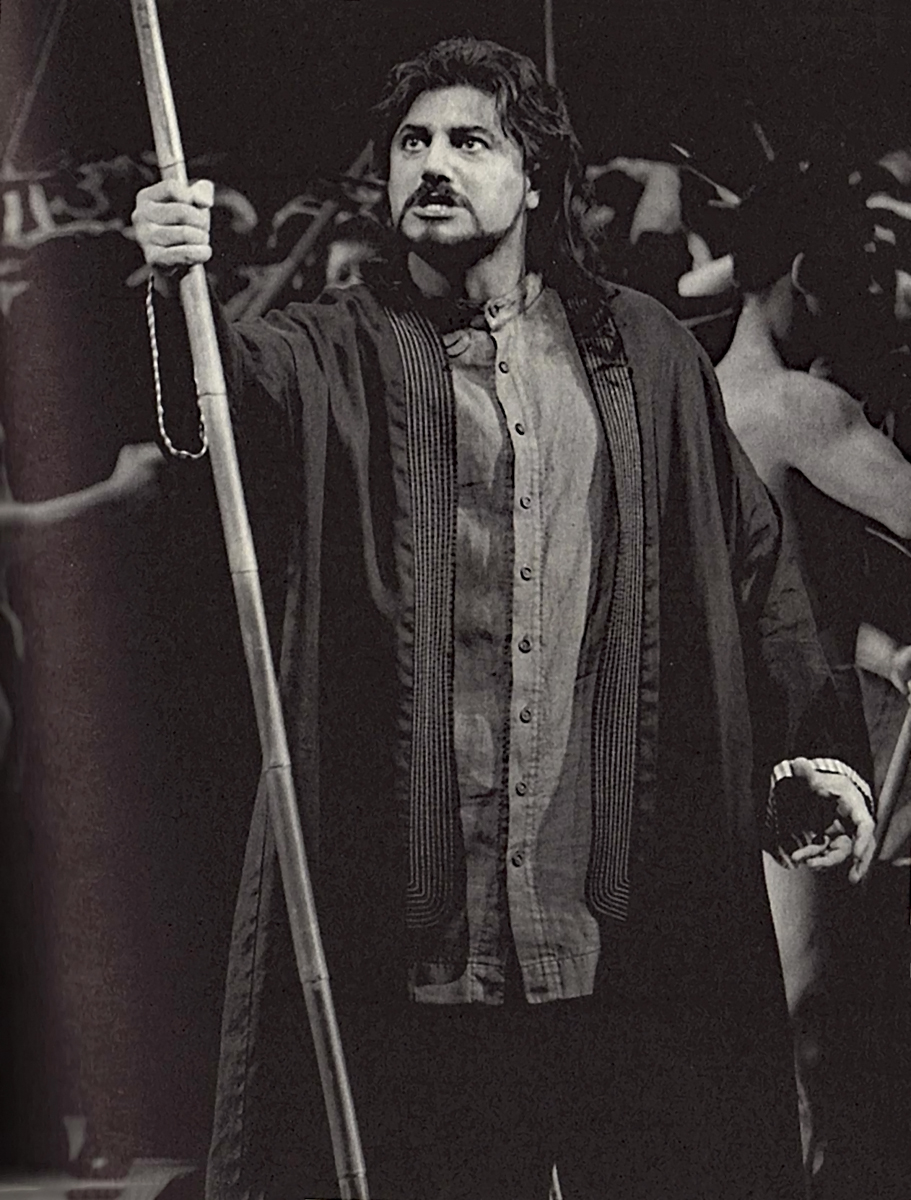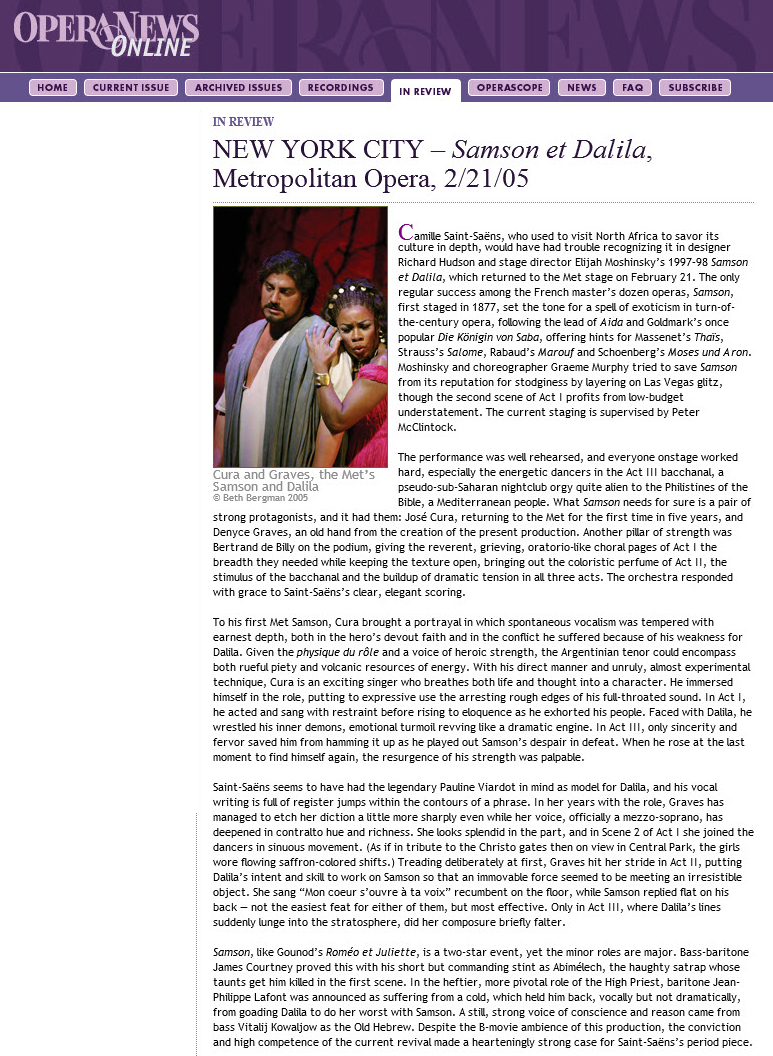
Bravo Cura
Celebrating José Cura--Singer, Conductor, Director
Operas: Samson


NYC - 2005

Reviews
|
Samson et Dalila, New York City, April 2005: ‘The Samson of the tenor José Cura, returning to the Met for the first time since his debut performances as Turiddu in Cavalleria rusticana in 1999, is the big news of the revival. The 42-year-old Argentine tenor has had an unorthodox career, which began with extensive training as a conductor, choral director and composer. He was 30 before he committed to a career as an operatic tenor. With his powerful voice, hunky physique and animal magnetism he quickly developed an ardent following. Vocal purists may still fault his singing for its lack of finesse and the sometimes patchy quality of the legato phrasing. But the clarion power and burnished colorings of his voice offered exciting compensations. Clearly a solid musician, he sang with rhythmic integrity and admirable dynamic shadings. Still, it was sheer vocal willpower and dramatic risk-taking that gave his portrayal such impact. During the love scene, he sang Samson's climactic top notes lying on his back with Ms. Graves cuddled over his chest. In the prison scene, when Samson, blinded, shorn of hair and sapped of power, turns the mill wheel to which he is chained, Mr. Cura captured the pitiable state of this broken man through his halting steps and anguished singing. Mr. Cura's Samson is the reason to take in this revival.” New York Times, April 2005
Samson et Dalila, New York City, March 2005: “Samson is a real hero of this opera and José Cura was the main attraction in these performances. His Samson is a charismatic Israelite leader, a warrior as well as Dalila's former lover. The beginning of Act III was the most dramatic, impressive and convincing moment of this staging. The captured, betrayed, shorn and blinded Samson turns the millstone, shackled to it. Effective lights illuminate the tragic leader who betrayed his nation because of his love for Dalila. Samson asked God to save the Israelites and to punish only him. His aria ‘Vois ma misere, helas!’ was one of the strongest moments in the opera. Cura is not only an extraordinary vocalist but thanks to his experience as a conductor and a universal musician, he's a rare example of a thinking tenor. That's something!” Kamerton, April 2005
Samson et Dalila, New York City, March 2005: “Saint-Saëns' orgy music inspired many a Biblical movie score, and there is a touch of Hollywood in the Met's show—most notably, in the persons of tenor José Cura and mezzo Denyce Graves. He is tall and strapping; she is regal and voluptuous; both are comely and command the stage. There is chemistry between them, as when Graves' Dalila strokes and nuzzles Cura's resistant Samson, who then follows her beckon like a helpless child. Bloodied and battered with his arms outstretched, Cura's Samson at the millstone resembles Jesus on the cross—a plausible image by the standards of Christian typology, which sees Samson's sacrifice as prefiguring Christ's. While Cura's acting was affecting, his singing was uneven. Back at the Met for the first time since his 1999 debut, he showed few signs of artistic decline or growth. His voice is dark and beautiful in its lower and middle ranges; he tends to bark his way through high phrases (though he nailed his final B-flat); and his enunciation is cloudy. His vocalism ranged from disciplined (a stirring rebuke to the Hebrews in Act I) to willful (crooning and gasping in the millstone scene).” Newsday, February 2005
Samson et Dalila, New York City, March 2005: “To his first Met Samson, Cura brought a portrayal in which spontaneous vocalism was tempered with earnest depth, both in the hero’s devout faith and in the conflict he suffered for his weakness for Dalila. Given the physique du role and a voice of heroic strength, the Argentinian tenor could encompass both rueful piety and volcanic resources of energy. With his direct manner and unruly, almost experimental technique, Cura is an exciting singer who breathes both life and thought into a character. He immersed himself in the role, putting to expressive use the arresting rough edges of his full-throated sound. In Act I, he acted and sang with restraint before rising to eloquence as he exhorted his people. Faced with Dalila, he wrestled his inner demons, emotional turmoil revving like a dramatic engine. In Act III, only sincerity and fervor saved him from hamming it up as he played out Samson’s despair in defeat. When he rose at the last moment to find himself again, the resurgence of his strength was palpable.” Opera News, May 2005
Samson et Dalila, New York City, March 2005: “Argentine hunk José Cura, whose 1999 Met debut as Turiddu proved severely disappointing, finally returned to the company with a stronger––if still uneven––effort. His Samson, in execrable French––how can such an ambitious artist permit himself this lapse?––commands heroic stature physically and, at least in the upper register, vocally, making his visually committed, dynamic assumption theatrically impressive, even if the tone itself was often unbeautiful and the technique varied puzzlingly from effective to peculiar, phrase to phrase. Cura fared best with the anguished intensity of the third act.” Gay City News, 31 March – 1 April 2005
Samson et Dalila, NYC, February 2005: “When José Cura arrived at the Metropolitan Opera in September 1999, he became the first tenor since Enrico Caruso in 1903 to be given a debut at the house's opening night of the season. But after his three performances as Turiddu in Cavalleria rusticana over an eight-day span that fall, Cura stayed away from the Met, building his career as a singer and conductor in Europe. He returned triumphantly this week in the Met's revival of Saint-Saëns' Samson et Dalila, displaying the clear, robust voice and steamy good looks that have earned him acclaim. Based on Thursday night's performance, the second in a run of seven through March 19, the 42-year-old Argentine has become a major artist. Cura combined with mezzo-soprano Denyce Graves for a moving love scene in the second act, when both took turns singing while lying on their backs. With blood on his face and his voice filled with pain, he was thrillingly dramatic as he turned the mill at the start of the third act, after his hair had been cut and he had been blinded. His French phrasing occasionally sounded less than perfect, but that didn't detract from the overall portrayal. In the post-Three Tenors era, he is among the most exciting tenors around.” Associated Press, 25 February 2005
|

|
Cura Returns to Met
Associated Press 25 February 2005
[Excerpt] NEW YORK - When Jose Cura arrived at the Metropolitan Opera in September 1999, he became the first tenor since Enrico Caruso in 1903 to be given a debut at the house's opening night of the season. But after his three performances as Turrido in "Cavelleria Rusticana" over an eight-day span that fall, Cura stayed away from the Met, building his career as a singer and conductor in Europe. He returned triumphantly this week in the Met's revival of Saint-Saens' "Samson et Dalila," displaying the clear, robust voice and steamy good looks that have earned him acclaim. Based on Thursday night's performance, the second in a run of seven through March 19, the 42-year-old Argentine has become a major artist. Cura combined with mezzo-soprano Denyce Graves for a moving love scene in the second act, when both took turns singing while lying on their backs. With blood on his face and his voice filled with pain, he was thrillingly dramatic as he turned the mill at the start of the third act, after his hair had been cut and he had been blinded. His French phrasing occasionally sounded less than perfect, but that didn't detract from the overall portrayal. In the post-Three Tenors era, he is among the most exciting tenors around.
|
|
|
|
|
Love Me Tenor
New York Post Ernesto Lechner 23 February 2005
A Want more? The Argentinian tenor, who will perform at the Met throughout February and March reprising his critically acclaimed lead role in Camille Saint-Saens's "Samson et Dalila," is also getting ready to publish his first book of photographs. No wonder critics accuse Cura of being an arrogant, self-proclaimed Renaissance man - a claim that he is quick to dismiss. "It's not arrogance," he exclaims. "I think you need to be humble in order to admit that you have a number of talents and you're ready to suffer greatly in order to develop them." Cura discovered his gift for singing almost by accident. A native of Rosario, a picturesque city in the province of Santa Fe, Argentina, he landed his first conducting gig when he was 15. "I discovered the power of my own voice when I was taking singing lessons at the conservatory as part of my degree," he explains. "Some people stimulated my growth while others tried to stunt it. Things became easier when I moved to Europe." The tenor, who names "Samson" and Bizet's "Carmen" as his two favorite operas, has no qualms about facing the commercial realities of the highly competitive classical music business. "By singing opera, I became a better conductor," he offers. "You have to be realistic and realize that you are also a product within a market that has specific needs. If you try to invent your own reality, I don't think you'll last long." True to this philosophy, Cura opened his own record label in 2001. The company is branching out this year to include artist management and special events production. The tenor is not alone in this - his wife of 25 years acts as the company's general manager. "I was walking in downtown New York with my secretary the other day, wondering about my need to further complicate my life with more new projects," he says. "That's what happens to you when you have a restless temper. Even if I had a 50-hour day, it would feel short to me."
|
|
|
|
|
|
|
 |
|
|
Last Updated: Saturday, April 27, 2019 © Copyright: Kira